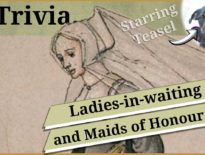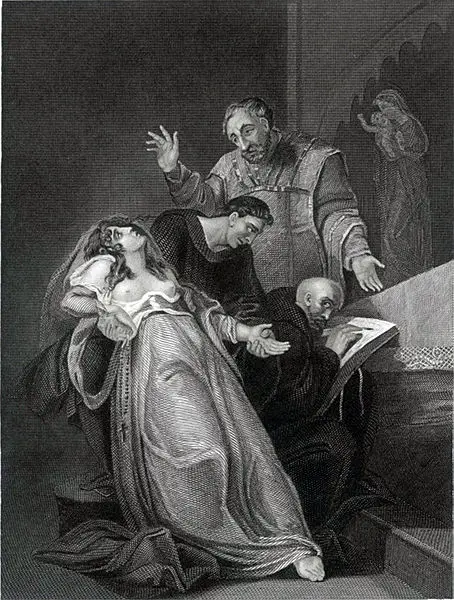Gertrude Courtenay was the daughter of William Blount, 4th Baron Mountjoy, and his wife Elizabeth, daughter of Sir William Say. Little is known about the early life of Gertrude, but we do know that she married Henry Courtenay, Earl of Devon, in 1519.
As Henry Courtenay was the first cousin of Henry VIII, Gertrude had married well and as such had a high place in court, attending the queen at the Field of Cloth of Gold in 1520. In 1525, her husband was created the Marquess of Exeter, making Gertrude a marchioness. Gertrude gave birth to a son named Edward in 1526, but her other son, Henry, died in infancy. When Henry VIII decided to divorce Katherine of Aragon, Gertrude’s husband signed the petition to the Pope asking him to grant an annulment. However, although supportive of the divorce, Exeter and Gertrude felt sympathy for Katherine and opposed the new evangelical ideas of Cromwell and Cranmer. As such, Gertrude became embroiled with Elizabeth Barton, the Holy Maid of Kent. Barton predicted the death of the king should he marry Anne, and such ideas were treasonous. Gertrude involved herself with Elizabeth Barton and travelled in secret to meet her and brought her to the Courtenay house in Surrey. When Barton was arrested for treason, Gertrude was cited in the investigation and wrote to Henry VIII to assure him of her loyalty, feigning ignorance of Barton’s treason.
Gertrude maintained a close relationship with Katherine of Aragon and Princess Mary, regularly sending presents to the queen. Eustace Chapuys named her the ‘sole consolation of the Queen and Princess’, such was the closeness of their relationship. Henry VIII, however, was aware of this relationship and thus chose Gertrude to be one of Princess Elizabeth’s godmothers, forcing Gertrude and her husband to show public allegiance to Queen Anne. Gertrude kept Chapuys up to date with goings-on at court and, following the execution of Anne Boleyn in 1536, was hopeful that Mary would be reinstated at court as a princess in her own right. However, when Mary was forced to sign the royal supremacy act and admit to her illegitimacy, these hopes were dashed. In October 1537, Gertrude carried the newly born Prince Edward at his christening, perhaps in another attempt to force her to adhere to the new line of succession.
In 1538, as Thomas Cromwell began to rise further at court, he saw Henry Courtenay as an obstacle to his ambition in the privy chamber. As such, on 5th November 1538, Gertrude was arrested for treason and sent to the Tower of London, where she was imprisoned for 18 months. Her son was also arrested, and he did not get released until 1553. Gertrude was penalised for her association with Elizabeth Barton and questioned about potential traitorous behaviours within her circle of friends. In a letter to Henry VIII dated 30th November, Gertrude professed her innocence, claiming her opinions were easily swayed because she was of the weaker sex. She was saved, but her husband was beheaded nine days after the date of the letter.
Following the death of her husband and her release from the Tower, Gertrude lived a rather difficult life. As her lands were forfeit to the crown, she will have experienced relative poverty. However, Mary did not forget her kindness. In 1553, following her accession to the throne, Mary summoned Gertrude to court, where she was rewarded for her service. Described as the queen’s bedfellow, Gertrude’s closeness to Mary is made explicit when Jane Dudley, in a letter to Anne Paget, claimed to have asked for Gertrude’s assistance in persuading the queen to save her husband’s life. Although not able to save Dudley, Gertrude apparently had a hand in saving the life of William Parr, Marquess of Northampton, which indicates her influence with Queen Mary. Gertrude, however, lost this influence when her son Edward was arrested for treason in February 1554. Gertrude was cast out of court and only gained readmission in the summer of 1555. Her son died in 1556, and two years later, Gertrude herself died on 25th September 1558. She is buried in Wimborne Minster in Dorset.
By Georgia Whitehead.
Georgia has just finished her masters in Classics at the University of Edinburgh. Academically, Georgia is interested in early Christianity, with her master's thesis focusing on "The Male Gaze and Self-Representation in Female Christian Narratives". In addition to her interest in ancient history, she has always been an avid lover of the Tudor era, drawn to the magnificence of the Tudor courts and the larger than life characters. She is particularly interested in The Reformation, Christianity and the shifting sands of ecclesiastical politics in this period and also has a keen interest in the lives of Tudor women. It is Georgia's ambition to become a writer, perhaps publishing her own Tudor novel one day.
Georgia also runs a history blog and instagram page called Historia Mundis.
Bibliography
- Cooper, J. P. D. "Courtenay, Gertrude, marchioness of Exeter (d. 1558)." Oxford Dictionary of National Biography. Oxford University Press 2004. Online Edition January 2004.
- H. Miller, Henry VIII and the English nobility (1986).
- C. Merton, ‘The women who served Queen Mary and Queen Elizabeth: ladies, gentlewomen and maids of the privy chamber, 1553–1603’, PhD diss., U. Cam., 1992.
- E. W. Ives, Anne Boleyn (1986).



I live in Torbay, and was born and bred in Exeter. The Courtnays are still at Powderham today. The castle looks out across the parkland, which has deer, to the Exe. The Coutnays are of interest to me for this reason. It’s nice to have all the information about Gertrude all pulled together in an article. Thanks very much for the article, Georgina.